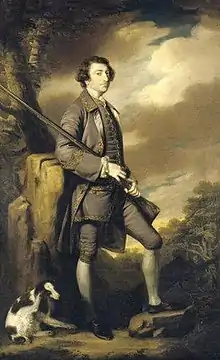Philip Eyre Gell
Philip Eyre Gell (1723-1795) of Hopton Hall near Wirksworth, Derbyshire was a wealthy lead-mining aristocrat.[1]

Philip Eyre Gell was the son of John Eyre and Catherine Gell (sister of Sir Philip Gell, 3rd Baronet).[2] The family's fortune was founded on the local lead industry, through its ownership of the lead tithes in the mines of Bakewell, Hope and Tideswell.[3] He is known for building the road between his lead-mining interests at Hopton, near Wirksworth area with a new smelter at Cromford. He named the route Via Gellia as a testimony to his family's claimed descent from the Romans.[4] He was High Sheriff of Derbyshire in 1755.[3] In 1777 textile entrepreneur Richard Arkwright leased a corn mill from Philip and converted it to spin cotton, using his water frame. It was the first cotton mill in the world to use a steam engine.[5]
His father John Eyre had assumed the surname Gell after inheriting the Gell family fortune from his brother-in law Sir Philip Gell. John died in 1739 and the lands of Hopton Hall were inherited by his eldest son Philip Eyre Gell. Philip married the poet Dorothy Milnes (daughter and coheir of William Milnes of Aldercar Park). His brother was Admiral John Gell. When Philip died in 1795, he left the Hopton estate to his eldest son Philip Gell MP (1775-1842). His second son was the renowned antiquarian Sir William Gell.[4]
The archive of documents from the Gell family of Hopton Hall is held by the Derbyshire Record Office.[3]
References
- "GELL of Hopton,Derby". Archived from the original on 24 October 2019. Retrieved 29 June 2020.
- John Burke, John Bernard Burke A genealogical and heraldic history of the extinct and dormant baronetcies
- "D258/10/86/62 - Gell of Hopton Hall". Derbyshire Record Office. Retrieved 20 January 2021.
- "WIRKSWORTH-Parish Records 1608-1899-Hopton Hall Auction". www.wirksworth.org.uk. Retrieved 2 July 2020.
- Fitton, R. S. (1989), The Arkwrights: spinners of fortune, Manchester: Manchester University Press, p. 57, ISBN 978-0-7190-2646-1, retrieved 14 August 2010